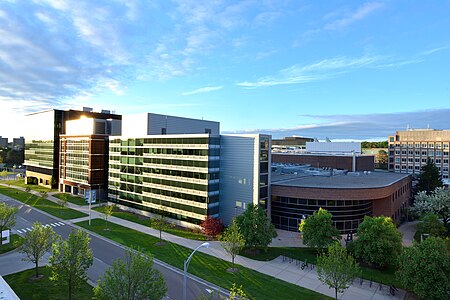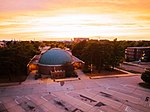Facility for Rare Isotope Beams

The Facility for Rare Isotope Beams (FRIB) is a scientific user facility for nuclear science, funded by the U.S. Department of Energy Office of Science (DOE-SC), Michigan State University (MSU), and the State of Michigan. Michigan State University contributed an additional $212 million in various ways, including the land. MSU established and operates FRIB as a user facility for the Office of Nuclear Physics in the U.S. Department of Energy Office of Science. At FRIB, scientists research the properties of rare isotopes to advance knowledge in the areas of nuclear physics, nuclear astrophysics, fundamental interactions of nuclei, and real-world applications of rare isotopes. Construction of the FRIB conventional facilities began in spring 2014 and was completed in 2017. Technical construction started in the fall of 2014 and was completed in January 2022. The total project cost was $730M with project completion in June 2022. FRIB will provide researchers with the technical capabilities to study the properties of rare isotopes (that is, short-lived atomic nuclei not normally found on Earth). Real-world applications of the research include materials science, nuclear medicine, and the fundamental understanding of nuclear material important to nuclear weapons stockpile stewardship. More than 20 working groups specializing in experimental equipment and scientific topics have been organized through the FRIB Users Organization. The FRIB will be capable of expanding the known Chart of the Nuclides from some approximately 3000 identified isotopes to over 6000 potentially identifiable isotopes. It will accelerate beams of known isotopes through a matrix which will disrupt the nuclei, forming a variety of unusual isotopes of short half-life. These will be 'filtered' by directing away the wrong charge/mass isotopes by magnetic field, leaving a small beam of the desired novel isotope for study. Such beam can also target other known isotopes, fusing with the target, to create still further unknown isotopes, for further study. This will allow expansion of the Chart of the Nuclides towards its outer sides, the so-called Nuclear drip line. It will also allow expansion of the Chart towards heavier isotopes, towards the Island of stability and beyond.The establishment of a Facility for Rare Isotope Beams (FRIB) is the first recommendation in the 2012 National Academies Decadal Study of Nuclear Physics: Nuclear Physics: Exploring the Heart of the Matter. The priority for completion is listed in the 2015 Long Range Plan for Nuclear Science: Implementing Reaching for the Horizon by the DOE/NSF Nuclear Science Advisory Committee. The facility has a robust Health Physics program under the umbrella of the university's Environmental Health and Safety department.
Excerpt from the Wikipedia article Facility for Rare Isotope Beams (License: CC BY-SA 3.0, Authors, Images).Facility for Rare Isotope Beams
South Shaw Lane, East Lansing
Geographical coordinates (GPS) Address Nearby Places Show on map
Geographical coordinates (GPS)
| Latitude | Longitude |
|---|---|
| N 42.724780555556 ° | E -84.473827777778 ° |
Address
Facility for Rare Isotope Beams
South Shaw Lane 640
48824 East Lansing
Michigan, United States
Open on Google Maps





